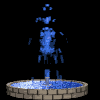_____From 1930
until the mid '60s, Rastafari was a local Jamaican religious movement
with few outside influences. Several Garveyite leaders had independently
declared that Haile Selassie fulfilled Garvey's prophecy, and the movement
remained dominated by independent "Elders" with widely varying
views. Not only did no Jamaica-wide "Rastafarian Church" develop,
but there was not even agreement on basic doctrine or a canon of Scripture--both
the Holy Piby and the King James Bible were used by various Elders, but
were freely emended and "corrected". OVERSTANDING: This "anarchy"
was considered a virtue by classical Rastas. Rastafari was not a religion,
a human organization, or a philosophy, but an active attempt to discern
the will of JAH (God) and keep it. Classical Rastas were mainly uneducated
Third World peasants, but they approached Rastafari in an almost Talmudic
spirit, holding "reasonings" --part theological debate, part
prayer meeting-- at which they attempted to find the Truth.
Their attitude differed, however, from that of Protestants interpreting
the Bible. They were certain that they would arrive, by divine guidance,
at an "overstanding" (rather than understanding) of the Truth.
The Truth cannot be known by human effort alone, but "Jah-Jah come
over I&I", one can participate in the One who is Truth.
Mysticism
_____Early Rasta mystical experience emphasized the immediate presence of JAH within the "dread" (God-fearer). The doctrine of theosis was expressed with great subtlety (although not all Elders correctly distinguished essence from energy). Through union with JAH, the dread becomes who he truly is but never was, a process of self-discovery possible only through repentance. (For this reason, Rastas did not proselytize, but relied on compunction sent by JAH.) The mystical union was expressed by the use of the pronoun "I&I" (which can mean I, we, or even you, with JAH present) or simply "I" in contrast to the undeclined Jamaican dialect "me".
Community
_____Many Rastas
lived (and live today) in the bush in camps ruled by an Elder. Some of
these camps are segregated by sex and resemble monasteries (down to the
gong at the gate); more often, they are reconstituted West African villages.
The dreads observe the rules of "ital", a dietary code based
on the Pentateuch with various additions, and otherwise observe a spiritual
rule. Males are usually bearded (uncommon in Jamaica during the classical
period, and a cause of social and religious discrimination, so that Rastas
who held jobs often were "baldfaces" who kept their affiliation
secret.)
The famous "dreadlocks" were worn during the classical period
only by a minority of dreads, mostly those who had taken the oath of Nazirite.
Very recent historical research suggests that the dreadlocks were popularized
by a monastic movement which opposed the unrestrained and potentially
corrupting power of the Elders. These celibate and almost puritanical
"nyabinghi warriors" objected particularly to "pagan holdovers"
in Rastafari, the continued use by dreads of ritual practices associated
with the voudoun-like folk religion of the Jamaican peasantry.


